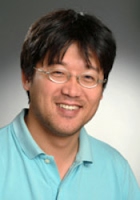
Two scientists at the University of Louisville, together with German researchers, have discovered a method unknown up to this time by which the biological process of allostery occurs, a finding that has implications for better focused therapeutic treatments with fewer side effects.
Donghan Lee, Ph.D. and David Ban, Ph.D., both with the Department of Medicine and the James Graham Brown Cancer Center at UofL, joined with researchers from the Max Planck Institute for Biophysical Chemistry in Goettingen, Germany, in looking at allostery, the process in which biological macromolecules such as proteins transmit the effect of binding at one site to another, often distant, functional site.
“This important study documents the significance of very basic cancer research and will likely lead to the identification and development of novel targeted treatments which otherwise would not have been discovered,” said Donald M. Miller, M.D., Ph.D., director of the James Graham Brown Cancer Center, a part of KentuckyOne Health.
At the atomic level, the UofL and German research group found a previously unidentified way for allostery to occur through the collective motion of an entire protein structure.
“Much drug development focuses on targeting a protein,” Lee said. “The thinking is that if you block a certain action of a certain protein, then you can cure or at least, delay progression of a disease.
“However, in order to understand what to block, you must understand the function of the protein structure. That is the direction we took.”
The group used ubiquitin, a small protein that is highly abundant in cells of higher organisms. With newly developed computational algorithms, the research team was able to determine atomic structures representing what was the previously invisible allosteric motion within ubiquitin.
That motion was fast, said the researchers. “There have been limitations in the ability to observe fast protein motions,” Ban said. “However, we developed a technique that overcame the previous experimental limitations. Having a better, more precise and more accurate ability to measure the movement, we can now build an atomic model that enables us to visualize what the motion actually looks like.”
Lee likens the process to stopping a wide receiver on the football field. The wide receiver has to catch the ball with his arms and hands while also running with his legs and feet. The speed of his legs is affected by the action of catching the ball with his arms.
“So if we just block one leg, his ability to run and actually catch the ball will be impaired,” Lee said. “That’s what we did in the lab: We saw we could block one thing to affect others.”
A single peptide bond was key, Ban said. “In looking at the functional aspect of this protein, it all boiled down to a single peptide bond that flipped in or out. That is amazing: we could affect a distant region by manipulating a single peptide bond.
“We were able to make mutants of this certain protein that would lock it in one state or another.”
The potential therapeutic benefit of the findings could result in more focused treatments with fewer side effects.
“Chemotherapy, for example, attacks multiple, different proteins and there are a lot of side effects,” Lee said. “But conceivably, we need only one protein blocked – just like we only need to block one leg of the wide receiver to stop him. Our study begins to help us target that one correct protein without impairing others.”
“Our findings give us, for the first time, the tools to look at many different systems,” Ban said. “We can apply this to other medically and biologically relevant systems.”
Other members of the research team are Colin A. Smith, Supriya Pratihar, Karin Giller, Maria Paulat, Stefan Becker, Christian Griesinger and Bert L. de Groot. The group’s study, “Allosteric switch regulates protein-protein binding through collective motion,” was published in March in the Proceedings of the National Academy of Sciences.




























